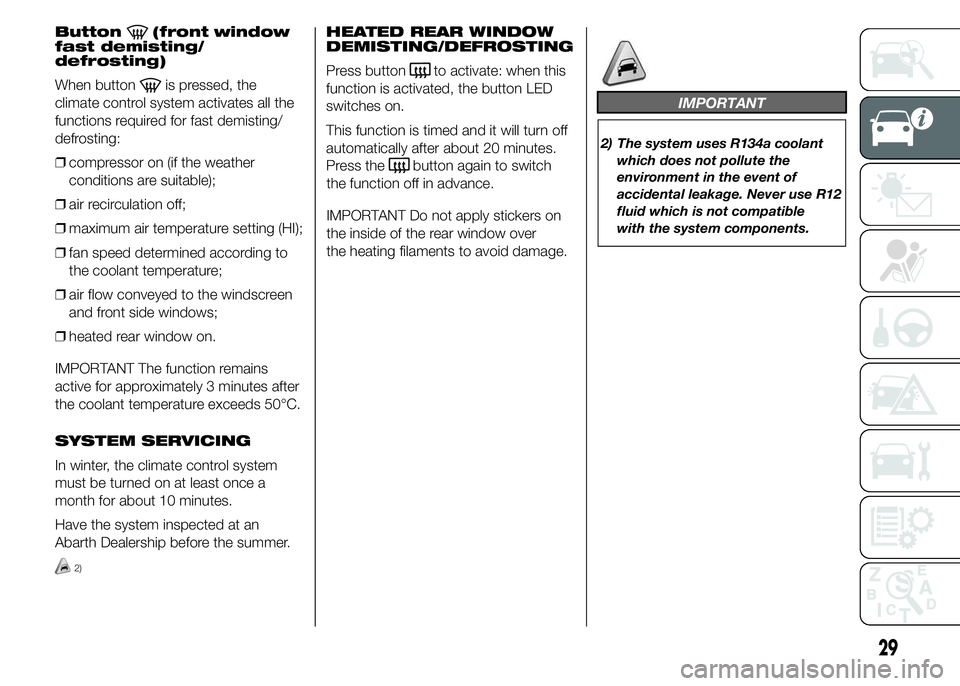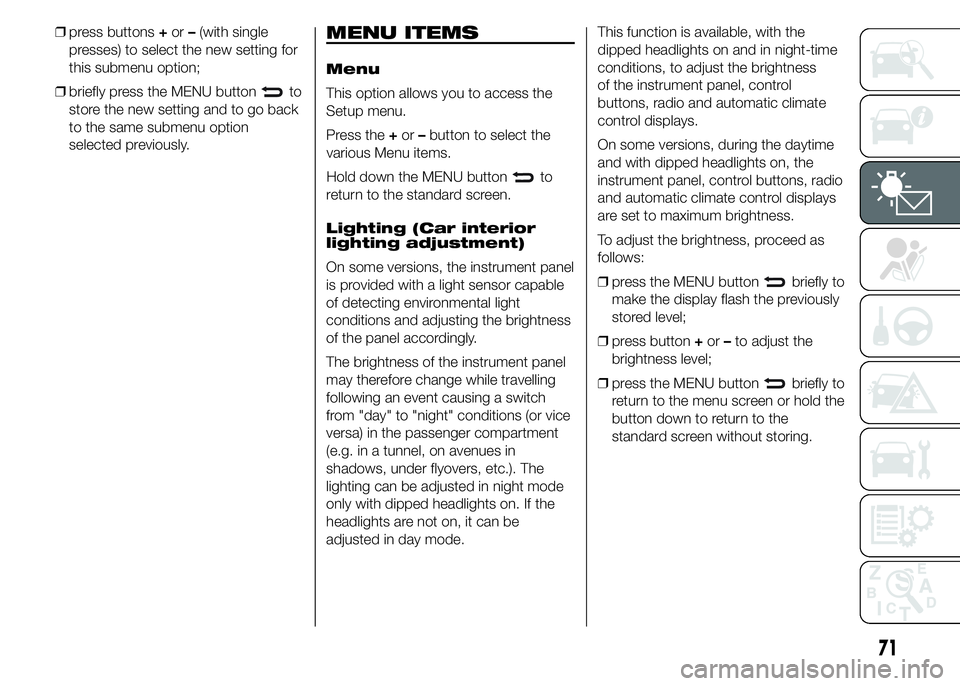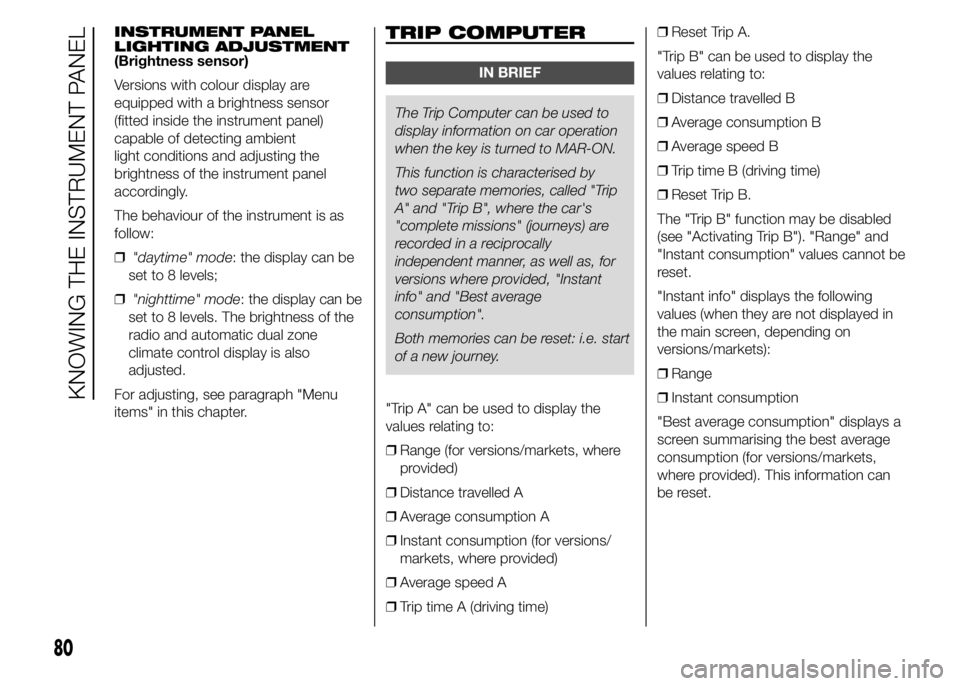2016 Abarth 500 climate control
[x] Cancel search: climate controlPage 33 of 215

Button(front window
fast demisting/
defrosting)
When button
is pressed, the
climate control system activates all the
functions required for fast demisting/
defrosting:
❒compressor on (if the weather
conditions are suitable);
❒air recirculation off;
❒maximum air temperature setting (HI);
❒fan speed determined according to
the coolant temperature;
❒air flow conveyed to the windscreen
and front side windows;
❒heated rear window on.
IMPORTANT The function remains
active for approximately 3 minutes after
the coolant temperature exceeds 50°C.
SYSTEM SERVICING
In winter, the climate control system
must be turned on at least once a
month for about 10 minutes.
Have the system inspected at an
Abarth Dealership before the summer.
2)
HEATED REAR WINDOW
DEMISTING/DEFROSTING
Press button
to activate: when this
function is activated, the button LED
switches on.
This function is timed and it will turn off
automatically after about 20 minutes.
Press the
button again to switch
the function off in advance.
IMPORTANT Do not apply stickers on
the inside of the rear window over
the heating filaments to avoid damage.
IMPORTANT
2) The system uses R134a coolant
which does not pollute the
environment in the event of
accidental leakage. Never use R12
fluid which is not compatible
with the system components.
29
Page 75 of 215

❒press buttons+or–(with single
presses) to select the new setting for
this submenu option;
❒briefly press the MENU button
to
store the new setting and to go back
to the same submenu option
selected previously.
MENU ITEMS
Menu
This option allows you to access the
Setup menu.
Press the+or–button to select the
various Menu items.
Hold down the MENU button
to
return to the standard screen.
Lighting (Car interior
lighting adjustment)
On some versions, the instrument panel
is provided with a light sensor capable
of detecting environmental light
conditions and adjusting the brightness
of the panel accordingly.
The brightness of the instrument panel
may therefore change while travelling
following an event causing a switch
from "day" to "night" conditions (or vice
versa) in the passenger compartment
(e.g. in a tunnel, on avenues in
shadows, under flyovers, etc.). The
lighting can be adjusted in night mode
only with dipped headlights on. If the
headlights are not on, it can be
adjusted in day mode.This function is available, with the
dipped headlights on and in night-time
conditions, to adjust the brightness
of the instrument panel, control
buttons, radio and automatic climate
control displays.
On some versions, during the daytime
and with dipped headlights on, the
instrument panel, control buttons, radio
and automatic climate control displays
are set to maximum brightness.
To adjust the brightness, proceed as
follows:
❒press the MENU button
briefly to
make the display flash the previously
stored level;
❒press button+or–to adjust the
brightness level;
❒press the MENU button
briefly to
return to the menu screen or hold the
button down to return to the
standard screen without storing.
71
Page 84 of 215

INSTRUMENT PANEL
LIGHTING ADJUSTMENT
(Brightness sensor)
Versions with colour display are
equipped with a brightness sensor
(fitted inside the instrument panel)
capable of detecting ambient
light conditions and adjusting the
brightness of the instrument panel
accordingly.
The behaviour of the instrument is as
follow:
❒"daytime" mode: the display can be
set to 8 levels;
❒"nighttime" mode: the display can be
set to 8 levels. The brightness of the
radio and automatic dual zone
climate control display is also
adjusted.
For adjusting, see paragraph "Menu
items" in this chapter.TRIP COMPUTER
IN BRIEF
The Trip Computer can be used to
display information on car operation
when the key is turned to MAR-ON.
This function is characterised by
two separate memories, called "Trip
A" and "Trip B", where the car's
"complete missions" (journeys) are
recorded in a reciprocally
independent manner, as well as, for
versions where provided, "Instant
info" and "Best average
consumption".
Both memories can be reset: i.e. start
of a new journey.
"Trip A" can be used to display the
values relating to:
❒Range (for versions/markets, where
provided)
❒Distance travelled A
❒Average consumption A
❒Instant consumption (for versions/
markets, where provided)
❒Average speed A
❒Trip time A (driving time)❒Reset Trip A.
"Trip B" can be used to display the
values relating to:
❒Distance travelled B
❒Average consumption B
❒Average speed B
❒Trip time B (driving time)
❒Reset Trip B.
The "Trip B" function may be disabled
(see "Activating Trip B"). "Range" and
"Instant consumption" values cannot be
reset.
"Instant info" displays the following
values (when they are not displayed in
the main screen, depending on
versions/markets):
❒Range
❒Instant consumption
"Best average consumption" displays a
screen summarising the best average
consumption (for versions/markets,
where provided). This information can
be reset.
80
KNOWING THE INSTRUMENT PANEL
Page 129 of 215

SAVING FUEL
GENERAL
CONSIDERATIONS
Car maintenance
Checks and adjustments should be
carried out in accordance with the
"Scheduled Servicing Plan" (see
chapter "Maintenance and care").
Tyres
Check the tyre pressures at least once
every four weeks: if the pressure is
too low, consumption levels increase as
resistance to rolling is higher.
Unnecessary loads
Do not travel with an overloaded
luggage compartment. The weight of
the car and its arrangement greatly
affect fuel consumption and stability.
When transporting particularly large
objects, use a trailer if possible.
Roof rack/ski rack
Remove the roof rack or the ski rack
from the roof after use. These
accessories lower aerodynamic
penetration and adversely affect
consumption levels.Electrical devices
Use electrical devices only for the
amount of time needed. The heated
rear window, additional headlights,
screen wipers and heater fan require a
considerable amount of energy;
increasing the current uptake increases
fuel consumption (by up to +25% in
an urban cycle).
Climate control system
Using the climate control system will
increase consumption: use the air vents
when the temperature outside permits.
Devices for
aerodynamic control
The use of non-certified devices for
aerodynamic control may adversely
affect air drag and consumption levels.
DRIVING STYLE
Cranking
Do not warm up the engine at low or
high revs when the car is stationary;
this causes the engine to warm up
more slowly, thereby increasing fuel
consumption and emissions. It is
therefore advisable to move off
immediately, slowly, avoiding high
speeds: in this way the engine will
warm up more quickly.Unnecessary actions
Avoid accelerating when stopped at
traffic lights or before switching off the
engine. The latter action, as well as
double-declutching, is unnecessary and
causes increased fuel consumption
and pollution.
Gear selection
Use a high gear when traffic and road
conditions allow it. Using a low gear for
faster acceleration will increase
consumption. In the same way
improper use of a high gear increases
consumption, emissions and engine
wear.
Max. speed
Fuel consumption considerably
increases as speed increases. Maintain
a constant speed, avoiding
unnecessary braking and acceleration,
which cost in terms of both fuel
consumption and emissions.
Acceleration
Accelerating violently severely affects
consumption and emissions:
acceleration should be gradual and
should not exceed the maximum
torque.
125
Page 150 of 215

DASHBOARD FUSE BOX
fig. 123
DEVICE PROTECTED FUSE AMPERE
Right dipped headlight power supply F12 7,5
Left dipped headlight and headlight alignment control unit
power supplyF13 7,5
Engine compartment junction unit switch F31 5
Front, rear and luggage compartment roof lights F32 7,5
Diagnosis socket, radio, climate control, EOBD F36 10
Brake light switch, instrument panel node F37 5
Central door locking F38 15
Windscreen/rear window washer pump F43 15
Driver's side electric windows F47 20
Passenger side electric window F48 20
Parking sensor, control backlighting, electric mirrors F49 5
Airbag node F50 7,5
Radio switch,Blue&Me™, climate control system, brake
lights, clutchF51 7,5
Instrument panel node F53 5
146
IN AN EMERGENCY
Page 151 of 215

ENGINE COMPARTMENT FUSE BOX
DEVICE PROTECTED FUSE AMPERE
Climate control fan F08 30
AvailableF09 15
Acoustic warnings F10 15
Engine management system (secondary loads) F11 10
Main beam headlights F14 15
Electric roof motor F15 20
Powertrain Control Module F17 10
AvailableF18 7,5
Air conditioning compressor F19 7,5
Heated rear window, mirror defrosters F20 30
Fuel pumpF21 15
Ignition coilF22 15
Powertrain Control Module F22 20
Braking system (control unit, valves) F23 20
+15 Braking system, electrical steering, yaw sensor F24 7,5
Fog lightsF30 15
AvailableF84 10
Front power socket (with or without cigar lighter) F85 15
147
Page 195 of 215

FUEL CONSUMPTION
The fuel consumption figures given in the tables below are determined on the basis of the type-approval tests laid down by
specific European Directives.
The procedures below are followed for measuring consumption:
❒urban cycle: cold starting followed by driving that simulates urban use of the car;
❒extra-urban cycle: frequent accelerating in all gears, simulating extra-urban use of the car: speed varies between 0 and
120 km/h;
❒combined consumption: calculated with a weighting of approximately 37% of the urban cycle and 63% of the extra-urban
cycle.
IMPORTANT The type of route, traffic conditions, weather conditions, driving style, general condition of the car, trim level/
equipment/accessories, use of the climate control system, car load, presence of roof racks and other situations that adversely
affect the aerodynamics or wind resistance lead to different fuel consumption values than those measured.
FUEL CONSUMPTION ACCORDING TO THE CURRENT EUROPEAN DIRECTIVE (litres/100 km)
Versions Urban Extra-urban Combined
1.4 TB PETROL ABARTH 8.5 5.4 6.5
191
Page 211 of 215

INDEX
A
BS .............................................. 53
ABS (system) ................................. 53
Air cleaner ...................................... 162
Analogue pressure gauge............... 79
Automatic climate control
system ......................................... 26
Battery .......................................... 162
– advice for extending lifetime ...... 162
– inspecting the charge ................ 162
– replacement .............................. 162
Battery (recharging) ........................ 149
Bodywork (cleaning and
maintenance) ............................... 167
Bodywork (warranty) ...................... 167
Bonnet ........................................... 48
Brake fluid ...................................... 160
Brakes ........................................... 177
Bulbs
– bulbs (replacement) ................... 135
– general instructions ................... 135
– types of bulbs ........................... 136
Car inactivity ................................. 128
Carrying children safely .................. 105
Checking levels .............................. 159
Cigar lighter.................................... 36
Cleaning and maintenance
– car interior ................................. 169
– leather parts .............................. 169– plastic parts .............................. 169
– seats ......................................... 169
Climate control
– Passenger compartment air
diffusers .................................... 21
Climatic comfort ............................. 21
Clutch ............................................ 176
CO2 emissions............................... 192
CODE Card .................................... 11
Control panel and on-board
instruments .................................. 78
Controls ......................................... 34
Correct reading of the rim .............. 181
Correct tyre reading ....................... 180
Cup/bottle holders ......................... 38
Daytime running lights (DRL) ......... 30
Digital engine coolant
temperature gauge....................... 79
Digital fuel level gauge .................... 79
Dimensions .................................... 184
Dipped headlights (bulb
replacement) ................................ 140
Dipped headlights/side lights ......... 30
Direction indicators (bulb
replacement) ................................ 139
Direction indicators ........................ 31
Display ........................................... 68
Doors ............................................. 42
– Door central
locking/unlocking ...................... 42
– door locking/unlocking .............. 42– opening/closing with the key ..... 42
Driver side knee bag ...................... 115
Driver's side front airbag ................ 114
Dualdrive electric power steering .... 59
EBD (Electronic Brake force
Distribution) .................................. 53
eco Index ....................................... 69
Electric windows ............................ 44
Engine codes - bodywork
versions ....................................... 173
Engine compartment (washing) ...... 168
Engine coolant ............................... 160
Engine............................................ 174
– marking ..................................... 172
Engine oil (consumption) ................ 160
Engine oil (level check) ................... 160
EOBD system ................................ 59
ESC (Electronic Stability Control)
system ......................................... 52
External lights................................. 30
Fiat CODE system......................... 10
Fitting "Universal" child restraint
system ......................................... 107
Fixed glass roof .............................. 40
Fix&Go Automatic (kit) .................... 131
Flashing ......................................... 30
Fluids and lubricants ...................... 188
Fog lights (bulb replacement) ......... 140
Fog lights/rear fog light................... 35
Follow Me Home (device) ............... 31